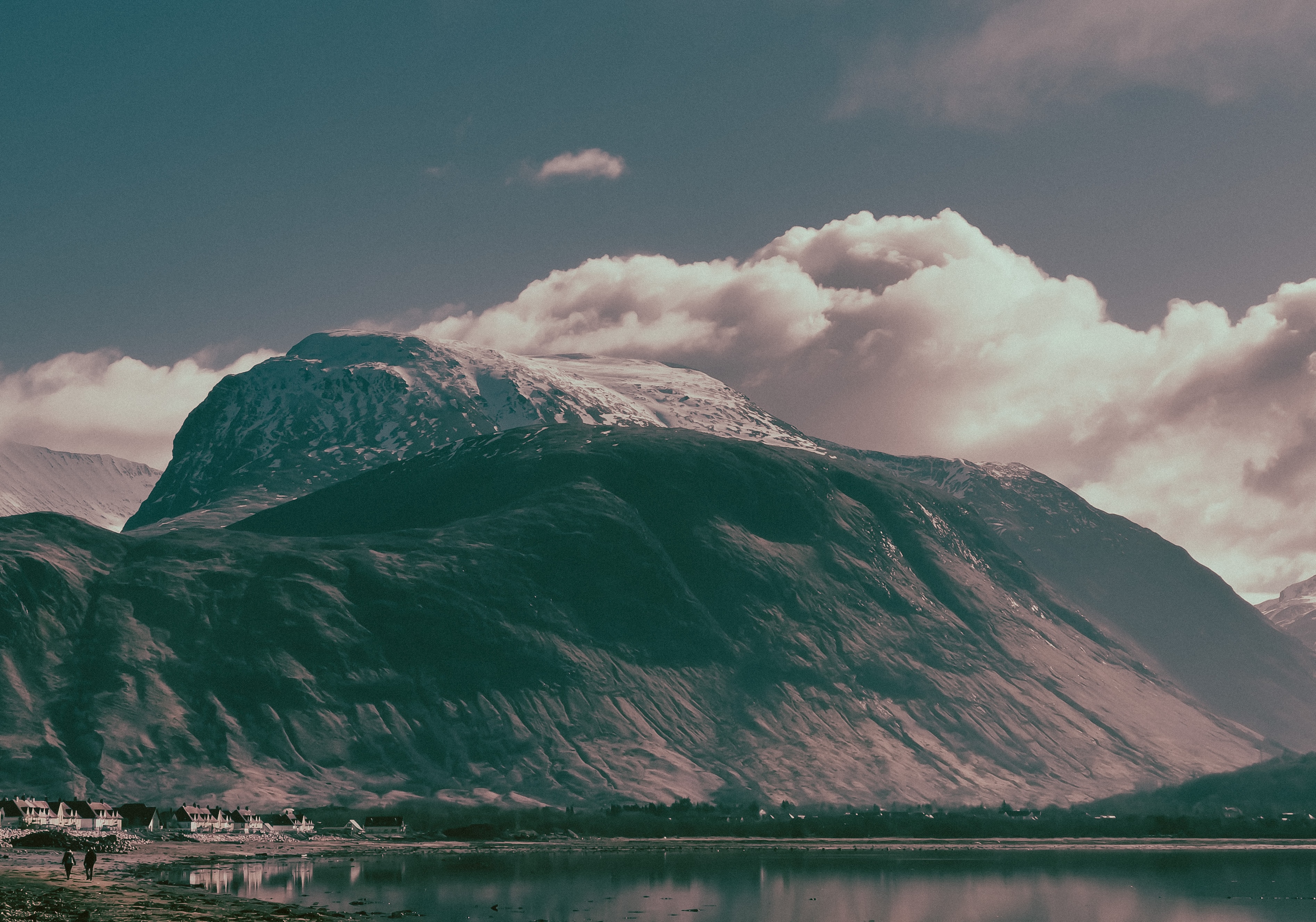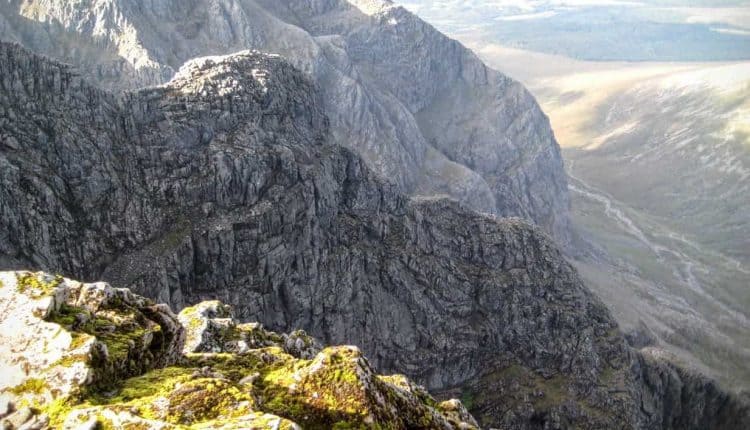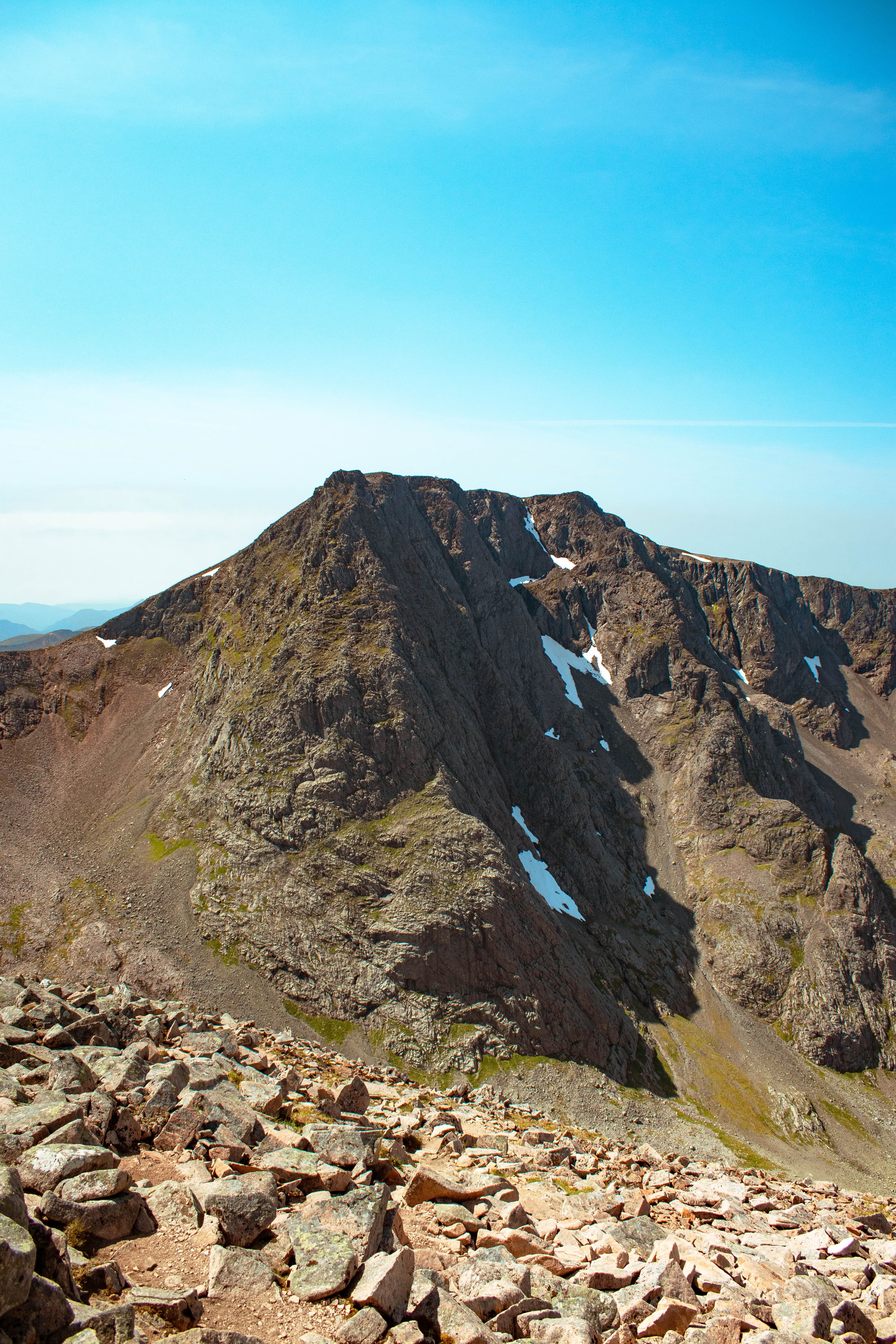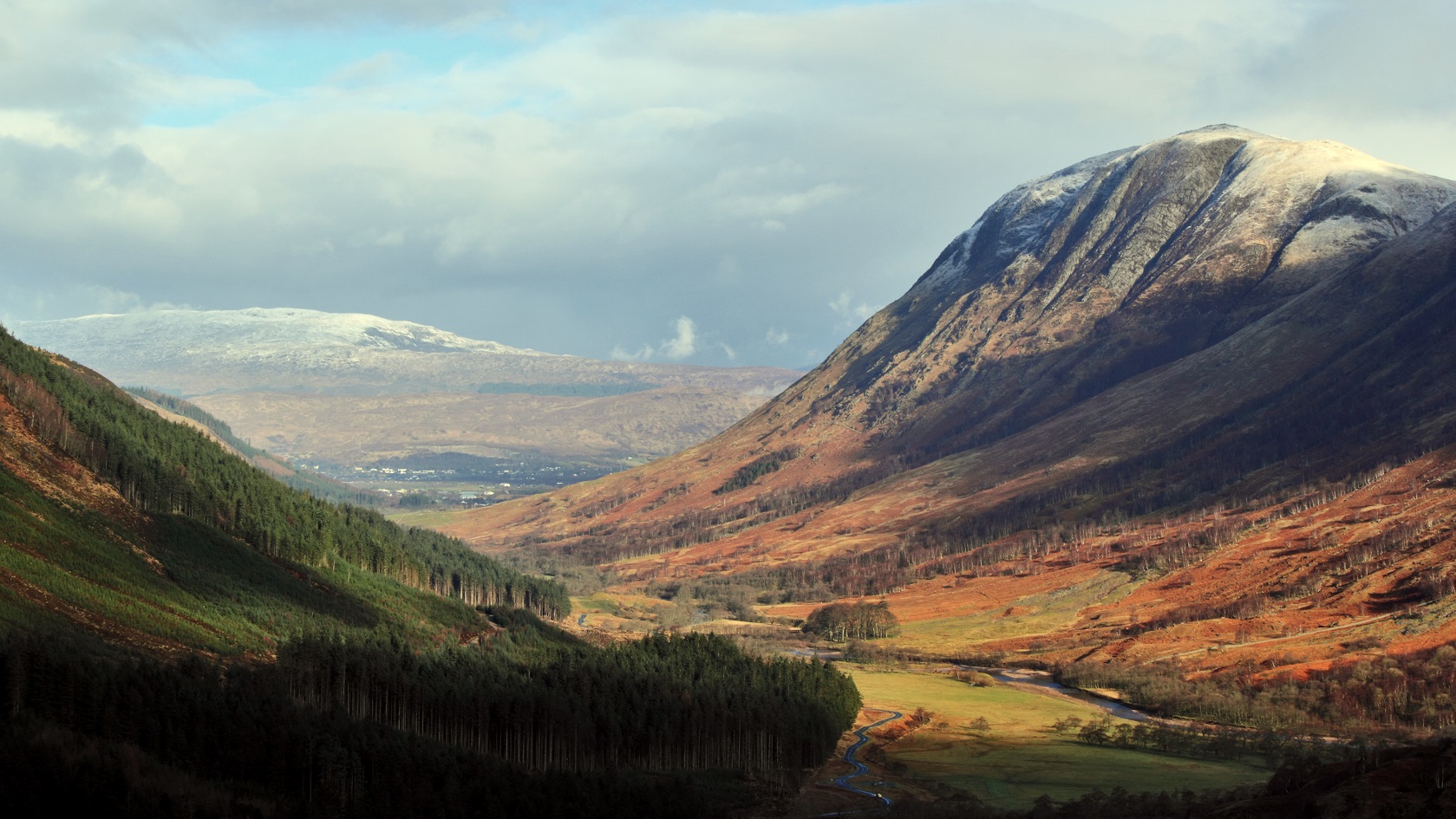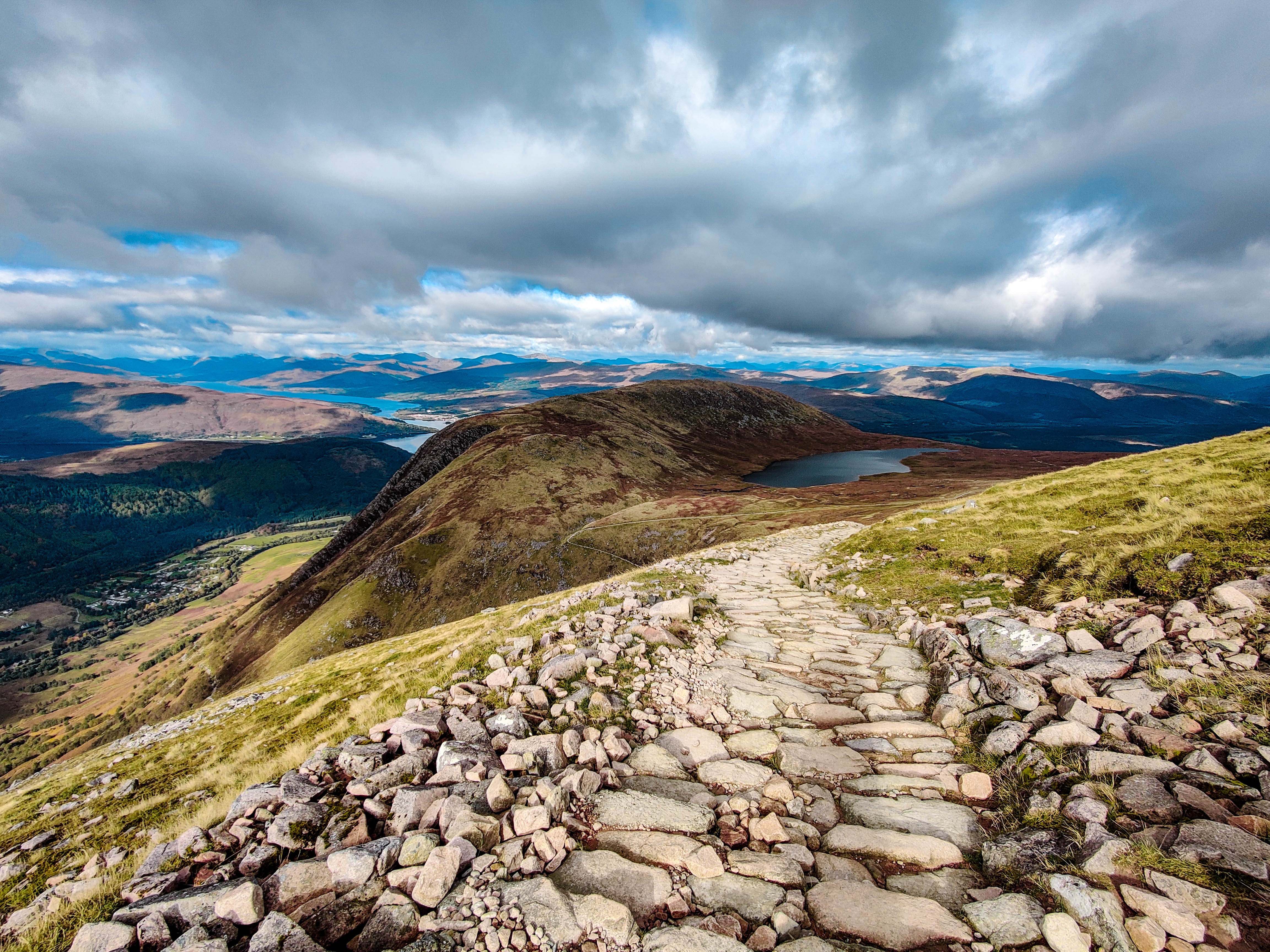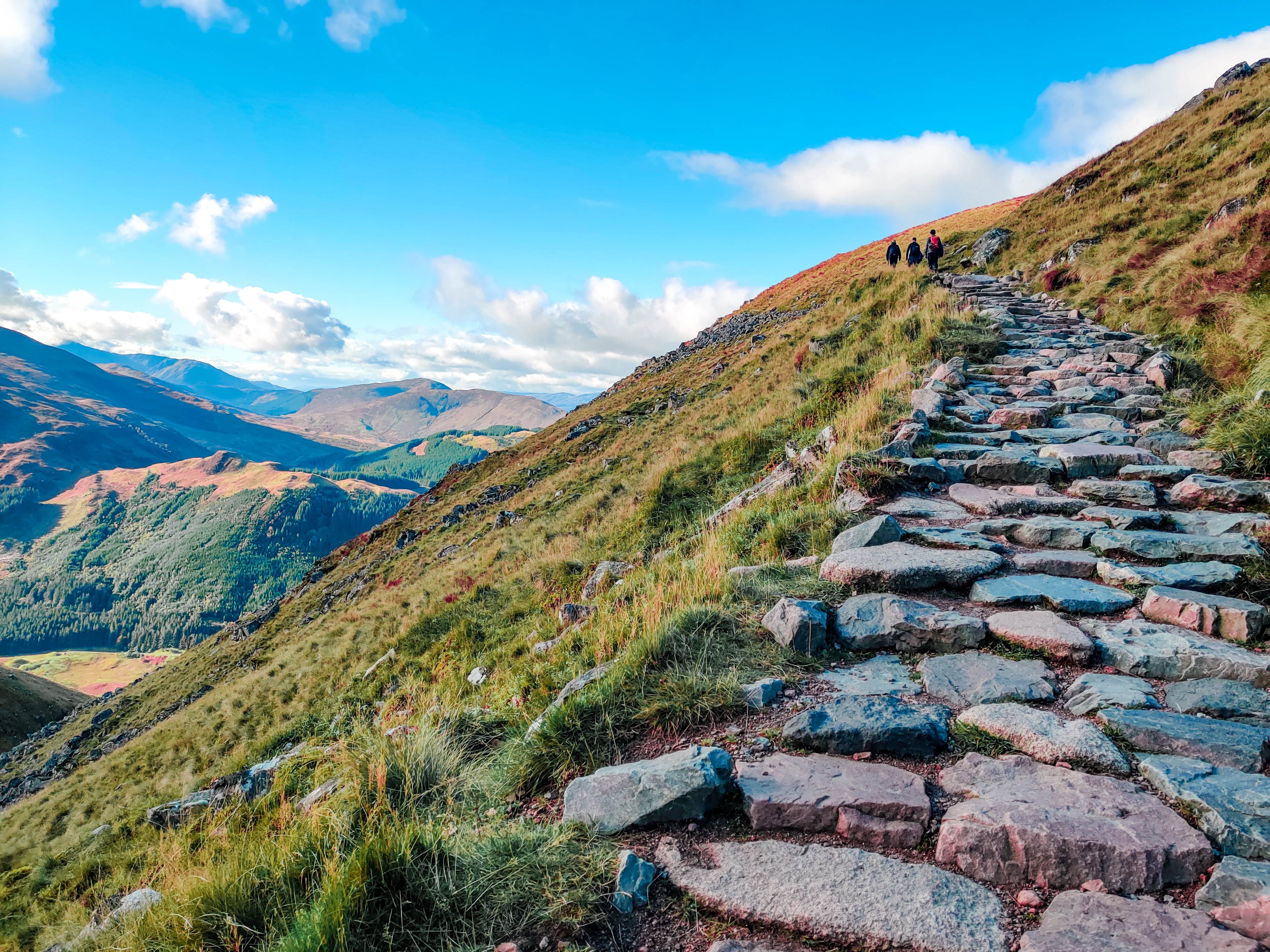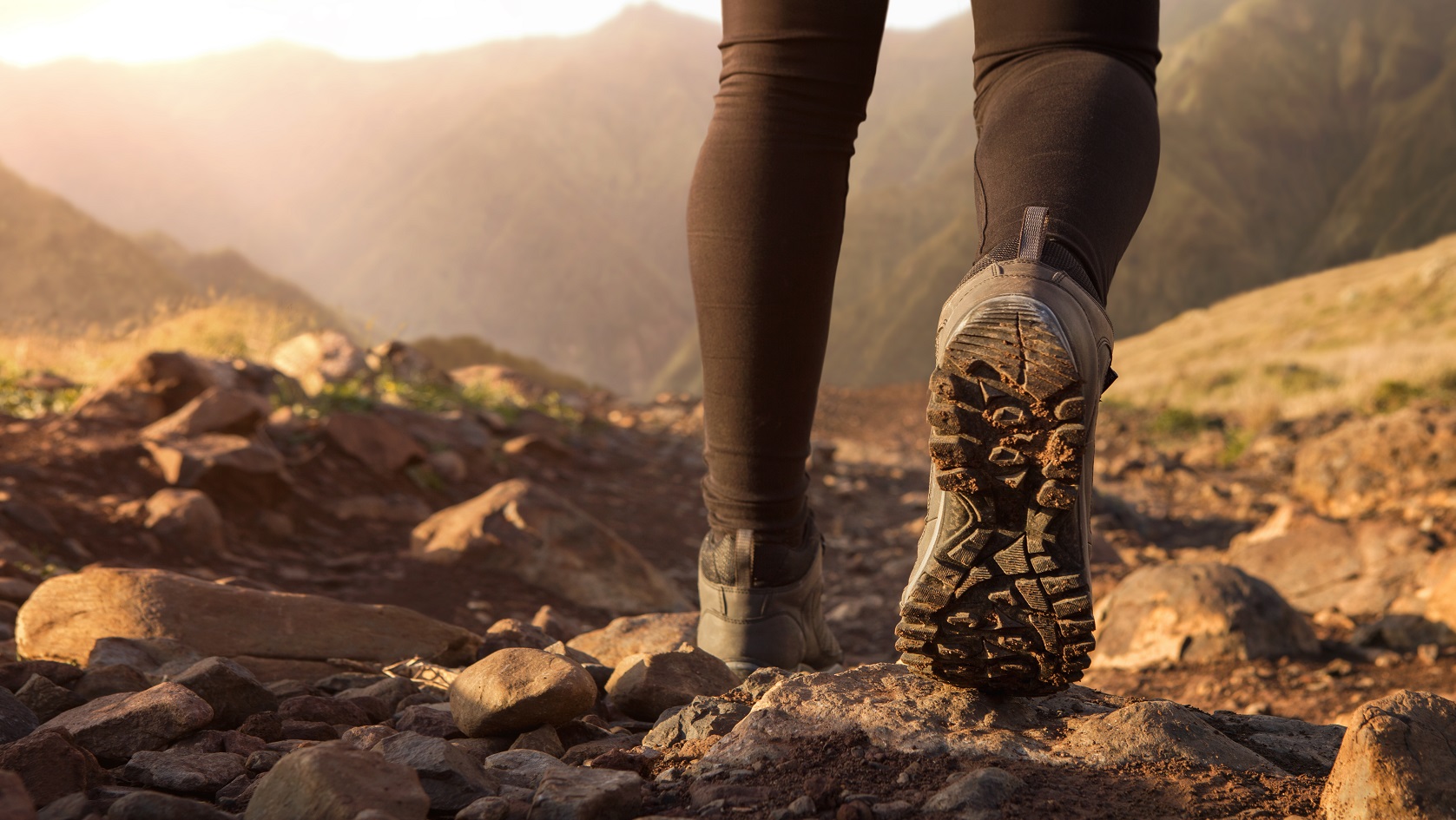Ben Nevis, located in the Scottish Highlands, is the highest mountain in all of Britain. Standing at a towering 1,345 metres (4,413 ft) above sea level, Ben Nevis dominates the landscape around Fort William where it is situated. Known to locals as simply "The Ben", this imposing peak attracts around 150,000 ascents per year, making it Britain's most popular and busiest mountain. The height of Ben Nevis makes it a fascinating natural wonder, but the mountain has much more to offer visitors beyond impressive elevation. Opportunities for hiking, sightseeing, history exploration and even whisky sampling can all be found in the majestic setting of Ben Nevis. Read on to discover everything you need to know to plan your adventure on the iconic Scottish peak.
Hiking Ben Nevis
As the highest mountain in Britain, bagging the summit of Ben Nevis is considered a quintessential peak-bagging quest for hikers across the UK and beyond. Luckily, there are a variety of designated trails that lead ambitious wanderers up slopes of varying difficulty to experience breathtaking views from the 1,345-meter summit.
The Main Hiking Trail - Ben Nevis Mountain Track
By far the most popular hiking route is the Mountain Track, sometimes referred to as the Tourist Route or Pony Track. This well-constructed path begins at Achintee on the east side of Ben Nevis about 2 kilometers from the heart of Glen Nevis. The trail then zigzags almost playfully up the south flank of Ben Nevis behind the youth hostel, delivering hikers an ever-expanding panorama as it climbs toward the summit. The Mountain Track covers a total linear distance of 8 kilometres with a staggering 1,300 meters of elevation gain over 4.5 miles. Most hikers need between 4-5 hours to complete the round-trip journey to the top of Ben Nevis and back via this route. Proper footwear, layers, food, water and emergency gear are absolute essentials for even seasoned alpinists before tackling the Mountain Track. For those seeking to extend hiking adventures on Ben Nevis, connecting trails like the Carn Mor Dearg Arête or the Castle Ridge Descent offer exciting alternatives for summit access and egress. These breath-taking ridge walks should only be attempted by skilled mountaineers comfortable with exposure and competent in navigating steep, scrambling terrain in all weather conditions, however.
The Carn Mòr Dearg Arête
Regarded by many seasoned Ben Nevis climbers as the finest ridge walk in Scotland, the Carn Mòr Dearg Arête trail presents a longer scrambling approach to the summit with incredible panoramas. The path starts from Achintee at Glen Nevis and follows a gradual incline northwest toward Lochan Meall an t-Suidhe, along the feet of Carn Dearg's North Face. Upon connecting with the ridge itself, the terrain turns steep and rocky with impressive exposure precipitously falling hundreds of feet on either side. This airy section known as the 'Crazy Pinnacles' continues along the narrow ridgeline marked with cairns for 1.2 kilometres leading to Carn Mòr Dearg's west peak. From the lesser summit, the arête widens slightly but still requires scrambling skills another kilometre to Ben Nevis’ actual 1,345-meter summit. Return options include reversing the entire ridge trail or descending from the cables either via the Mountain Track or the dangerous Castle Ridge route. The total distance covered is 19 kilometres over 14 hours for this strenuous circuit. Hence, supreme fitness and advanced orienteering abilities are vital prerequisites before tackling the Carn Mòr Dearg Arête.
Tower Ridge
Considered a classic mountaineering challenge in the UK, Tower Ridge presents experienced climbers with a 700-meter twisting journey up Ben Nevis’ intimidating North Face. The route begins easily enough from the Achintee area and ascends grassy slopes to the foot of Tower Ridge left of Observatory Gully. Once committing to the ridge itself, the climbing becomes significantly more technical (Difficult) with pitches weaving among towering rock towers and requiring scrambling skills with significant exposure. Fixed ropes and gears for safety belays ease passage up and down some vertical bulges above Coire na Ciste. Eventually, the spine of Tower Ridge intersects the main tourist footpath about 150 meters from Ben Nevis’ summit. Novice climbers should never attempt Tower Ridge without skilled guides and proper equipment given the highly changeable conditions common to Ben Nevis that drastically increase risks on such exposed terrain. Several fatalities have occurred over the years from climbers underestimating Tower Ridge in poor weather. But in fair conditions with proper preparations, few summit routes can match Tower Ridge for excitement and challenge.
The Imposing North Face of Ben Nevis
At over 1,300 metres from base to summit, the North Face of Ben Nevis showcases the most continuous vertical relief of any mountain in Britain. This towering headwall of contorted cliffs, hidden gullies and hanging glaciers presents experienced mountaineers with some of the most technical and thrilling ascents in the country – rated at Scottish Grade IV and V difficulty when ice-covered. In winter, frozen waterfalls and mixed rock and ice lines transform the intimidating face into an icy playground for expert alpinists only.
Classic North Face Ice Climbs
During the colder months from November through early spring, reliably frozen gullies on Ben Nevis’ North Face offer the most reliable ice and mixed climbs in Scotland. The steep walls of Orion Face Direct (IV,5) soar above the chaotic jumble of The Comb Gully to heights over 1000m straight up with few options to escape. Nearby, Point Five Gully (IV,4) plunges 600m down from Observatory Ridge, requiring two hard pitches of vertical ice to conquer. For those seeking the longest frozen challenge, the remote Gardyloo Gully (V,5) stretches the entire 1,300m height of the North Face over seven demanding pitches from base to summit. Even locating the inlet for some of these narrow and thinly iced gullies provides a navigation challenge itself in blizzard conditions common on Ben Nevis. And escaping deteriorating weather on the massive North Face can push even expert alpinists to their limits. Hence utilising qualified guides like West Coast Mountain Guides on frozen forays remains highly advised for safety.
Classic North Face Rock Climbs
In summer conditions with less ice and snow clogging approaches and routes across the broken cliffs of Ben Nevis’ North Face, skilled rock climbers flock to the mountain for adventure. The steep 300m slab of Centurion (E5) right of Orion Face provides desperate friction climbing at the grade with little opportunity for protection placement. To its right, the remote 370m-high wall of Fawlty Towers (E6) similarly demands continuous technical expertise thanks to its namesake crumbly rock characteristics. Perhaps the two most famous and sought-after rock routes snake their way up the Ministers of the North Face cliffs. Rhenus (E7) follows the most direct line linking right-facing corners in six long pitches. Next-door neighbour Slingsby’s Chimney (E6) journeys a parallel course to the left with overhanging off-width cracks and smooth face linking problems. Like their frozen cousins, descending these committing rock climbs often proves more perilous than the way up. Hence checking conditions and researching descent options should accompany preparations before tackling any classic North Face route.
Historical Significance of Ben Nevis
Beyond impressive elevation and hiking exploits, Ben Nevis has played a prominent role in Scottish history and culture dating back over 2000 years. From ancient hunters to modern map makers, generations of people have lived, worked and recreated among the slopes of this commanding peak. Remnants of their unique connections with Ben Nevis persist to intrigue visitors today.
Ancient History
Archaeological evidence suggests humans first inhabited areas surrounding Ben Nevis after the last Ice Age glaciers retreated roughly 8000 years ago. Remains of an Upper Neolithic settlement at Banavie date occupation back to 6,000 years ago. Game surely roamed nearby slopes which supported communities sporadically over subsequent millennia. Further clues of later Iron Age residency emerge at Dun Deardail hill fort brooding high above Glen Nevis, likely built around 2,000 years ago. Its stacked stone walls and prime vantage point provided strategic views and defence for local Celtic tribes when necessary. From the Roman conquest era onward, the lands around Ben Nevis saw fewer permanent settlements but likely hosted seasonal grazing and hunting activity. Place names in the area hint at continued Gaelic influence, including “Ben Nevis” itself perhaps meaning “Venomous Mountain” in ancient Scottish dialect. Folklore myths reinforce this linking of the mountain with magical powers and malevolent spirits much feared by clans utilising its foothills as handy game reserves.
Ben Nevis on Early Maps
It wasn’t until broader 18th-century Ordnance Survey initiatives that Ben Nevis and its exact height garnered specific scientific interest. Early topographers faced a dilemma determining accurate relative elevations and precise distance measurements between locations using basic trigonometry calculations and toolsets of the period. To assist in this complex triangulation process, Survey teams chose Ben Nevis to erect concrete markers for enhanced mapping accuracy across Scotland and beyond. In September of 1771, binning Royal Navy Lieutenant Thomas Oughterson climbed Ben Nevis to build a cairn at the summit, likely the first recorded ascent purely for cartography rather than adventure or access reasons. His associate Charles Hutton later cited Oughterson’s data in determining Ben Nevis’ height as 1,324 metres, just 21 metres shy of modern measurements. Further assistance came in 1847 when Observatory director Clement Lindley ascended the mountain to construct a substantial summit shelter along with an almost 16-foot iron pillar to improve longitude and latitude alignment readings. The legacy of these early mapping initiatives remains today in the form of the Charles Hutton Memorial Sundial erected outside the Ben Nevis Visitor Centre.
Visiting Ben Nevis: Accommodation and Dining Options
Ben Nevis annually attracts over 100,000 visitors, eager to experience Scotland’s highest mountain. Luckily, there is no shortage of quality accommodation and dining options located within proximity that provide weary climbers with places to rest their heads and refuel their bodies.
Accommodation in Fort William
The most sizeable town near Ben Nevis is Fort William, offering the widest variety and sheer numbers of lodging establishments for peak bagging tourists. Luxurious resort hotels like The Alexandra and The Inverlochy Castle cater to discerning travellers with premium rooms, restaurants and spas ideal for relaxing after a strenuous day on the mountain. Both locations place guests within 2 miles of Glen Nevis and the trailheads. For those seeking comfortable self-catering options closer to Ben Nevis, establishments like Glenmor and The Hayloft offer apartment rentals with kitchen access and laundry facilities. Old-school B&Bs such as Lime Tree Lodge, Craig Nevis and Ambleside Guest House provide cosy, affordable rooms throughout residential neighbourhoods of Fort William as well. Hostel picks like Glen Nevis Youth Hostel, Bank Street Lodge and Nevis Bank Inn Hostel deliver bunkbed dorms and private rooms on a budget, putting prime Highland adventure within the grasp of backpackers and big peak hopefuls. Reservations ensure availability at the most favourable locations.
Accommodation in Glen Nevis
Under 10 minutes by car yet worlds apart in ambience, scenic Glen Nevis offers a peaceful, picturesque alternative base camp to conquer Ben Nevis compared to bustling Fort William. Snuggled right at the trailhead for the main Mountain Track hiking route, accommodation options here place visitors mere steps from the peak ascent. Glen Nevis Camping & Caravan Club Site keeps things simple but comfortable with tent pitches, RV hook-ups and tidy shared facilities. Nearby Glen Nevis Bunkhouse and Laggan Guest House provide convenient lodging alternatives. But the real gem is Achintee Farm Guest House, whose converted 1700s cottages sit secluded below the very face of magnificent Ben Nevis awaiting exploration. Though lacking Fort William’s plentiful pubs and amenities, Glen Nevis lodging wins big for mountain access and idyllic atmosphere.
Where to Dine Before and After Ben Nevis Ascents
Replenishing calories following vigorous exercise on Ben Nevis proves both a requirement and a just reward for most visitors. Tucking into hearty Scottish fare at one of Fort William’s many eateries makes the perfect post-adventure treat. From classic pub food at Grog & Gruel to exquisite seafood at The Crannog, the town has no shortage of options to satisfy hungry hikers. But perhaps the most atmospheric venue to unwind with a dram and local brew remains the Ben Nevis Inn & Bunkhouse. At the trailhead for Britain’s highest summit, what better place to exchange epic accounts of conquest than this storied inn whose walls have hosted generations of adventurers just like you?
Ben Nevis Weather and Gear Considerations
Sitting 140 metres higher than any mountain south of it, Ben Nevis endures some of Britain’s most extreme weather shifts. Bitter cold, hurricane-force winds, sub-zero chill factors, whiteouts and rapid weather changes plague the massif regularly. Visitors venturing onto Scotland’s lofty roof should take special precautions to ensure safety and comfort during their high-level exploits by checking forecasts and packing proper gear.
Checking Ben Nevis Weather
Due to its remote Northern latitude position combined with impressive elevation, Ben Nevis holds snow cover through May most years and endures mean monthly temperatures barely above freezing even during summer months on its upper slopes. Wind speeds exceeding 125 mph and rainfall topping 7 inches during a single storm contribute to a sustenance Alpine environment decidedly different than valleys below. As such, checking detailed Ben Nevis weather in advance enables proper planning and gear selection to match conditions. Mountain forecasts from sources like the Met Office, MWIS and Scottish Avalanche Information Service provide invaluable data on expected temperatures, precipitation, visibility and wind speeds to anticipate before embarking onto the peak. Social media outposts like Twitter and Facebook offer real-time trip reports from recent summit attempts. And webcams allow a glimpse of actual scenarios atop the mountain that no forecast can match.
What to Pack for Ben Nevis Adventures
Once armed with an accurate weather outlook, visitors can tailor provisions and gear to best match anticipated conditions during their Ben Nevis adventure. Certain items form essential backbone layers in even the mildest forecast:
- Waterproof/Windproof Jacket & Pants
- Insulated Jacket
- Hiking Boots
- Hat & Glove Sets
- Headlamp
- Map/Compass/GPS
- Bivvy Bag/Blanket
- First Aid Supplies
Additional equipment gets added or subtracted depending on the season. For example...
- Winter (Nov-April) – Ice Axe, Crampons, Helmet
- Summer (May-Oct) – 30+ SPF Sunscreen, Sunglasses, Bug Spray
Regardless of when visiting, carrying sufficient food supplies, an insulated flask of hot tea or soup and emergency shelter to wait out passing storms proves vitally important. While checking conditions helps visitors prepare gear-wise, being mentally ready to turn around in worsening scenarios often makes the difference between an epic adventure or emergency rescue on mighty Ben Nevis.
Ben Nevis Distillery: Fine Whisky Born From Mountain Water
With the magnificent sight of Britain’s highest peak looming behind it, Ben Nevis Distillery has been crafting exquisite single-malt Scotch whisky just south of Fort William since 1825. Using pure water flowing down granite slopes of the famed mountain, several generations of master distillers have captured its uncompromising yet alluring spirit within each carefully created bottling of “the Dew of Ben Nevis”.
From Barley to Bottle
All production begins with selecting premium Golden Promise barley, the preferred variety for Scottish single malt whisky thanks to higher sugar content which maximises alcohol yield. Strict yeast cultivation controls fermentation over 90 gruelling hours to transform cereal starches into a final wash ready for distillation. Copper pot stills then perform two separate distillations, first separating alcohol from the water before conducting a spirited run that enriches flavours. By tradition, Ben Nevis ages all whisky for a minimum of ten years in oak casks to balance smooth yet robust characteristics. No chill filtering preserves the liquid’s natural gold hue tinted by mineral-rich water from on high.
Complex Yet Balanced Profile
A dram of Ben Nevis 10 Year Old seduces the senses with an intriguing bouquet of honey, heather and crisp apple interfused with subtle nutty cereal. Behind lies a delicate veil of wood smoke conjuring images of the mist-strewn mountain after which it’s named. The liquid glides over the palate, revealing flashes of malt and cinnamon spice layered among stone fruit syrups. A lingering finish balances sweet and dry tones with definitive complexity that deepens during special barrel strength releases. Among connoisseurs, such refined elegance combined with an alluring toffee richness epitomises the best of Highland single malt Scotch style. Each sip captures the rugged beauty of Ben Nevis whose liquid bounty enriches the spirit in every bottle.
Visiting The Iconic Distillery
One glimpse of the Ben Nevis distillery’s handsome whitewashed facade framed by rolling hills leaves no doubt about links between whisky production here and the natural grandeur of its towering namesake. The Visitor Centre allows guests to explore firsthand how pure mountain water, malted barley, and expert Copper stills unite under one roof to produce exceptional single malt. Guides share secrets behind maturing, blending and bottling processes before concluding tours with tutored tastings designed to showcase the Ben Nevis flavour profile. The ultimate way to experience Ben Nevis single malt finds travellers bellied up to the cosy bar inside The Ben Nevis Inn. Just 2km from the legendary distillery, this atmospheric inn has served weary climbers and adventurers since the 1800s. Sipping award-winning whisky by a crackling fire as frost glazes pines outside the window provides the perfect aprés mountain celebration that no snapshot could ever capture. One dram and you’re instantly back on the glorious summit of The Ben.
Ben Nevis Was Once Higher Than Mount Everest
As earth’s current tallest peak towering 8,848m over Nepal and Tibet, Mount Everest represents the ultimate mountaineering challenge worldwide. However, geological research reveals that eons ago Ben Nevis stood far taller than Everest’s present height before enduring extensive glacial erosion over millennia. Approximately 400 million years ago during the Devonian period, tectonic plate collisions between ancient continents Laurentia and Baltica created a mighty landmass known as Euramerica. This massive collision zone gave rise to an immense mountain chain exceeding even the modern-day Himalayas, aptly named the Ben Ohuerin Mountains. The remnants of this towering range exist today as Scotland’s rounded hills and mountains, with Ben Nevis forming the high point. Scientists estimate original heights for these Highland giants easily surpassed 14,000 feet (4267 m), shadowing modern Everest more than 3,000 m. However, half a million years of gradual glacial erosion during successive Ice Ages ultimately whittled the mighty Ben Ohuerin Mountains down to their current elevations. Visitors hiking Ben Nevis can still find evidence of this glacial activity gouging out mighty river valleys, sharp arêtes and bowl-shaped corries throughout the massif. Sheer cliff faces like the North Face provide clues to the catastrophic freeze-thaw erosion forces. The U-shaped glen containing the picturesque Steall Waterfall reflects classic glacial topography. While no longer Earth’s tallest summit, Ben Nevis still delivers superlative views and rewards worthy of a far grander mountain to the thousands who flock there yearly. As the proud remnants of a once Everest-eclipsing giant, Ben Nevis retains legendary status as Britain’s highest and most influential peak for nature enthusiasts today and far into the future.
Planning A Visit to Legendary Ben Nevis
Whether your interests include bagging Munros, tackling technical climbs or simply appreciating dramatic Scottish vistas, visiting legendary Ben Nevis should top every nature lover’s UK travel list. Use the following tips to help plan your adventure on Britain’s highest and most iconic mountain:
- Check Weather - Given frequent extremes in temperature, wind and visibility on Ben Nevis, checking mountain forecasts enables proper gear selection and flexible timing to match conditions.
- Book Local Accommodation - Fort William and Glen Nevis offer plentiful quality lodging options with easy access to Ben Nevis. Reservations secure ideal locations to launch your peak adventures.
- Pack Proper Gear - Sturdy hiking boots, breathable warm layers, waterproof outerwear and emergency provisions like headlamps, food and first aid minimise risks on Britain’s highest ground.
- Choose Route Wisely - Whether hiking the Mountain Track or attempting Tower Ridge, select Ben Nevis routes matching your expertise and fitness levels to ensure maximum safety and enjoyment.
- Relax & Refuel - Reward your physical efforts on the mountain by sampling Ben Nevis whisky or pub fare in nearby Fort William and soaking up spectacular Highland scenery.
By thoroughly preparing for extremes, packing proper provisions and pairing summit attempts with local history insights and hospitality, Ben Nevis continues to reward visitors seeking Britain’s best mountaineering adventures as it has for centuries. Use the guidance above to craft your own memorable experience on this iconic Scottish giant.
Related Articles

Let us know you agree to cookies
We use marketing, analytical and functional cookies as well as similar technologies to give you the best experience. Third parties, including social media platforms, often place tracking cookies on our site to show you personalised adverts outside of our website.
We store your cookie preferences for two years and you can edit your preferences via ‘manage cookies’ or through the cookie policy at the bottom of every page. For more information, please see our cookie policy.

